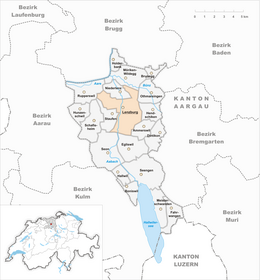Lenzburg
| Lenzburg | ||
|---|---|---|
 |
||
|
||
| Coordinates: 47°23′N 8°11′E / 47.383°N 8.183°ECoordinates: 47°23′N 8°11′E / 47.383°N 8.183°E | ||
| Country | Switzerland | |
| Canton | Aargau | |
| District | Lenzburg | |
| Government | ||
| • Mayor | Hans Huber FDP/PRD (as of 2008) |
|
| Area | ||
| • Total | 11.33 km2 (4.37 sq mi) | |
| Elevation | 405 m (1,329 ft) | |
| Population (Dec 2015) | ||
| • Total | 9,162 | |
| • Density | 810/km2 (2,100/sq mi) | |
| Postal code | 5600 | |
| SFOS number | 4201 | |
| Surrounded by | Ammerswil, Egliswil, Hendschiken, Möriken-Wildegg, Niederlenz, Othmarsingen, Rupperswil, Seon, Staufen | |
| Website |
www SFSO statistics |
|
Lenzburg is a town in the central region of the Swiss canton Aargau and is the capital of the Lenzburg District. The town, founded in the Middle Ages, lies in the Seetal valley, about 3 kilometres south of the Aare river. Lenzburg and the neighbouring municipalities of Niederlenz and Staufen have grown together in an agglomeration.
A Neolithic grave field of the Cortaillod culture has been discovered on the Goffersberg (close to the Lenzburg Castle) dating from 4300 - 3500 BCE. A Roman theater was uncovered when a motorway was built in 1964. It was part of a small settlement with 500 inhabitants that existed for approximately 200 years. The settlement was abandoned in the 3rd century. In the 5th and 6th centuries, an Alamanni settlement existed. Lenzburg is first mentioned in 924 as de Lencis.
In 1036, Lenzburg Castle was used for the first time as seat for the Count of Lenzburg, then an important lord. The house however died out in 1173, and the castle was then transferred to emperor Frederick Barbarossa. In the following period, it was mainly used by the Kyburger house. The Habsburgs took over the castle in 1273. City rights were granted in 1306.
Lenzburg was conquered by Bern in 1415, along with the western part of current Aargau, though Bern did not take away its city rights. In 1433, the city of Bern bought the castle and used it to govern the region from 1444 to 1798. A major fire devastated the town in 1491, sparing only fifteen houses. The Reformation was carried out simultaneously with the rest of the region in 1528, and the economy started to transform slowly from an agrarian to a more industrial one in the 16th century. In the 18th century Lenzburg developed into a centre for cotton trade and processing. An Indienne textile factory was founded in 1732.
...
Wikipedia



